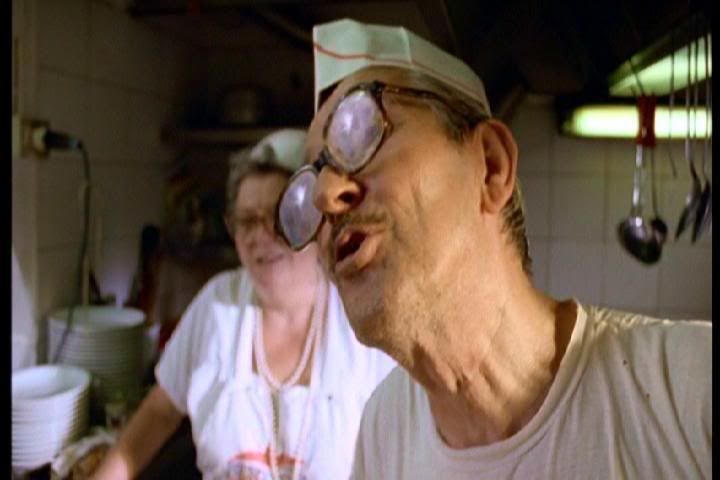
If it wasn't clear before the end that Werner Herzog's documentary account of the 16th Century Italian composer Carlo Gesualdo was a bit off-kilter, the film's last line clinches it. The final sequence of the film is set at a pageant in Gesualdo's hometown, with actors embodying the Devil and a flying cherub being sent on pulleys across the golden sunset sky. Herzog's final image is of a local actor playing a horseman, answering a cell phone and telling his mother that he'll be home soon, since "the Gesualdo film is almost over." And then he stares straight into the camera, and sure enough the Gesualdo film ends. This self-conscious breaking of the fourth wall caps a film in which the lurid life of Gesualdo — filled with murder, sexual depravity, and masochism, and seemingly in little need of further ornamentation — is blended with Herzog's obviously staged and ridiculous modern-day interjections and some performances of Gesualdo's music by amateur choirs. Gesualdo: Death for Five Voices is a typically ludicrous Herzog production, stretching credibility to such a degree that I was surprised to find out, in research after the documentary, that a great deal of the film was actually true.
Of course, that comment may seem strange, but only to those not familiar with Herzog's documentary methods. One would normally expect a documentary to tell the truth, but Herzog has dedicated his filmmaking career to discovering the "ecstatic truths" hidden under the more prosaic truth of the straight facts. This search normally encompasses the outright lying of Bells From the Deep, with its totally invented tales of Russian spirituality, or the twisted truth of Lessons of Darkness, in which images from the aftermath of the first Iraq war are given a new sci-fi story through voiceover. In this film, though, Herzog's technique is reversed. He's basically telling the truth here, and his account of Gesualdo's violent life is mostly accurate, although occasionally based on hearsay and rumors. The trick is that everything about the documentary, from its patchwork construction to its obviously staged interludes to its emphasis on strange local characters, is calculated to make this true story seem ridiculous, impossible, even hilarious despite its baroque violence.
The bulk of the story surrounds Gesualdo's murder of his first wife, Donna Maria d'Avalos, and her aristocratic lover, and the public display of their naked bodies afterwards. Herzog is also fascinated by Gesualdo's inventive music, which was largely ignored at the time and for centuries after his lifetime, but turned out to have an extraordinary influence hundreds of years later in the avant-garde of the late 19th Century, and especially on the important composer Stravinsky. The combination of Gesualdo's sensational life and his widely misunderstood music forms a perfect subject for Herzog, concerned as always with figures who exist at the edges of society and history. His presentation of both Gesualdo's life story and his musical legacy is remarkably straightforward. The latter is largely told by two choir directors, who are also shown directing their groups in performances of the music throughout the film. Meanwhile, the story of Gesualdo's murders and peculiar lifestyle is related by various local residents in the area around Gesualdo's castle, obviously coached by Herzog with what they should say. This story is occasionally adorned with extraneous details, like the assertion that when Gesualdo murdered his infant baby (a story that is, itself, only a conjecture), he suspended the child from a balcony, surrounded it with choirs singing madrigals, and left it outside for three days until it died. Herzog apparently can't resist adding such Grand Guignol details at several points, although the similarly baroque anecdote that a passing monk raped Donna Maria's corpse after her murder was apparently not Herzog's invention, but a real legend surrounding the Gesualdo story. This interplay between truth and fiction weaves all through the film, with Herzog largely sticking close to, if not the facts of history, then at least the genuine conjectures and legends that have sprung up around Gesualdo's wild life.
If the narrative line of the film is relatively clear and accurate, Herzog undermines this basic truthfulness with his insertions of blatantly invented, staged, and frequently humorous interludes between the more realistic documentary portions of the film. These digressions include a bagpipes player who enters Gesualdo's castle once a week, filling the space with his droning music in order to keep the castle's malevolent spirits at bay, and a hilarious scene with a cook who discusses the extravagance of Gesualdo's wedding menu while his wife keeps screaming about "the devil" in the background. There's also a local madwoman who believes she is the reincarnation of Donna Maria. Herzog stumbles across her singing operatically in a castle stairwell, and she leads the camera on a lengthy chase before finally telling her story and playing some of Gesualdo's music from a boombox she carries. Herzog's pursuit of the mad also leads him to a local asylum, where he films a totally unrelated sequence of a young retarded man riding a horse, before the asylum's director tells him about two men who both believe themselves to be Gesualdo, and the difficulties of keeping them apart from one another.
These increasingly unbelievable digressions, obviously invented by Herzog's fertile imagination, wind up casting doubt on everything in the film. The coexistence of Herzog's inventions with the actual facts of Gesualdo's life results in a weird dissonance between reality and fiction that is a hallmark of Herzog's "documentary" work. This inventiveness is the primary reason why Herzog's documentary oeuvre is such a treasure trove of masterpieces, perhaps even greater than his smaller corpus of narrative, fiction films. Death for Five Voices is a minor masterpiece in a career that has produced many such films, small documents of strange people and events, filtered through the lens of an equally strange imagination.

No comments:
Post a Comment